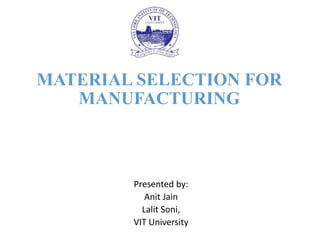
Material Selection Guide for Manufacturing Processes
- 1. MATERIAL SELECTION FOR MANUFACTURING Presented by: Anit Jain Lalit Soni, VIT University
- 2. MATERIAL SELECTION Material selection is a step in the process of designing any physical object. In the context of product design, the main goal of material selection is to minimize cost while meeting product performance goals. The designer of any product, other than software must get involved with material selection. Appropriate selection of material is significant for the safe and reliable functioning of a part or component.
- 3. Decisions, decisions! So many materials, so much information. How do we decide? How do we begin to choose?
- 4. MATERIAL SELECTION CHART o Materials selection chart are used for 2 common properties: 1. Young's modulus (which describes how stiff a material is) 2. Density. o On these charts, materials of each class (e.g. metals, polymers) form 'clusters' or 'bubbles' that are marked by the shaded regions
- 6. o From the material selection chart we can see immediately that: metals are the heaviest materials, foams are the lightest materials, ceramics are the stiffest materials. o Selection charts are really useful is in showing the trade- off between 2 properties, because the charts plot combinations of properties. o Like if we want a light and stiff material we need to choose materials near the top left corner of the chart - so composites look good. o There are a selection charts for many combinations of material properties, e.g. 'strength - toughness' and 'electrical resistivity - cost
- 7. STRATEGY FOR MATERIALS SELECTION There are mainly 4 steps: 1. Translation: Examining the design requirements to identify the constraints that they impose on material choice. 2. Screening-out: The immensely wide choice is narrowed first, by the materials that cannot meet the constraints. 3. Ranking: Further narrowing is achieved by ranking the candidates as per their ability to maximize performance 4. Seek supporting information
- 9. Translation The problem of selection of an engineering material for a component usually begins with setting up the 4 below things for target • Function: It refers to the task that the component is primarily expected to perform in service – for example, support load, sustain pressure, transmit heat, etc. • Constraints: That certain dimensions are fixed, that the component must carry the design loads or pressures without failure, that it insulates or conducts, that it can function in a certain range of temperature and in a given environment, and many more.
- 10. Objective: Refers to the target such as making the component functionally superior but cheap and light. In other words, the Objective refers to what needs to be minimized or maximized. Free variables: Certain parameters can be adjusted in order to optimize the objective—the designer is free to vary dimensions that have not been constrained by design requirements.
- 11. Material Index (M) The Material Index (M) refers to an attribute (or a combination of attributes) that characterizes the performance of a material for a given application. The material index allows ranking of a set of engineering materials in order of performance for a given application.
- 12. Material Indices can be better explained by following example Selection of Material for a Light and Strong Tie-Rod Now, as per the translation process
- 13. Material Index (M1) would provide a premise to examine if a material with higher weight (density) has to be selected to ensure that the same has sufficient strength to avoid failure.
- 14. Case Study – A Bike What is the function of a bike – obvious? How does the function depend on the type of bike? • Racing • Touring • Mountain bike • Commuter • Childs
- 15. • How is it made to be easily maintained? • What should it look like (colours etc.)? • What should it cost? • How has it been made comfortable to ride? • How do the mechanical parts work and interact?
- 16. The bike breaks down into various parts: • Frame • Forks • Wheels • Saddle • Etc.
- 17. We now need to look at the following for each part: • Requirements (mechanical, ergonomic, aesthetic etc.) • Function • How many are going to be made? • What manufacturing methods are we going to use?
- 18. Frame Materials • Steel – Strong, stiff, heavy, but cheap • Aluminium – weaker, lighter, more expensive than steel • Composite (CFRP) – strong, stiff, very light, but expensive to buy and to fabricate
- 19. Bike Frame
- 20. What Properties? • Mechanical – Strength, modulus etc. • Physical – Density, melting point. • Electrical – Conductivity, resistivity. • Aesthetic – Appearance, texture, colour • Processability – Ductility, mouldability • And last, but not least………. Cost, cost, cost!
- 21. Case Study (2) Drink Container • What are the requirements?
- 22. • Provide leak free environment for storing liquid. • Comply with food standards & protect liquid from health hazards. • For fizzy drinks, withstand pressure. • Brand image & identity • Easy to open • Easy to store & transport • Cheap for high volumes
- 23. Possible Materials • Steel • Aluminium • Glass • Plastic • Paper
- 24. THANK YOU
